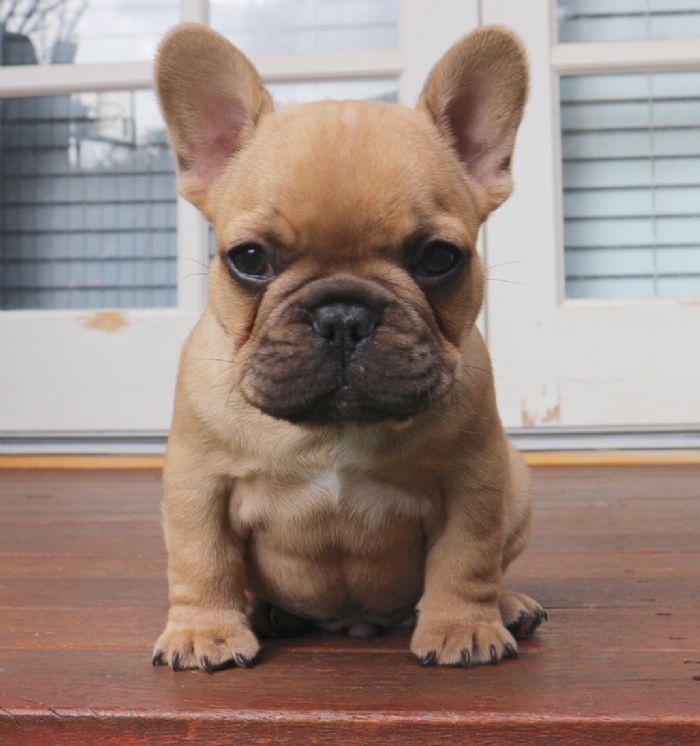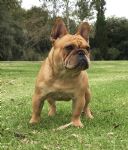French Bulldog Colours

(Fawn French Bulldog @braxthefrenchie on instagram)
Here at GrandElan we love dogs of all colours, shapes and sizes, especially our own beloved frenchies, but also other people’s frenchies of any colour. However no subject seems to get french bulldog breeders hotter under the collar than this subject of acceptable coat colours. As an ANKC registered breeder through DogsWest, we are bound by their code of ethics to breed only acceptable colours within the breed standard. The ANKC standard for French Bulldogs is taken from ‘the United Kennel Club (UK)’ standard which states as follows-
“Color
Acceptable colors include: fawn; brindle; fawn and white; brindle and white; and any other color that does not constitute a disqualification.
SOLID COLORED
Fawn: Solid coat. From light fawn to dark fawn, sometimes presenting a paler coloring, with or without a black mask, although masked subjects are preferred. Sometimes accompanied by limited white.
Brindle: Fawn coat moderately characterized by dark brindling, creating a tiger-marked effect. Strongly brindled coats must not cover the fawn ground color. A black mask may be present. Limited white is acceptable.
Fault: In fawns, a deep, black line extending along the spine. White stockings in brindles and fawns.
White dogs, with black nose and eyelids, are permissible.
COATS WITH WHITE
Fawn with moderate or significant white (Fawn and White): The white is ideally distributed over the entire body. Some fawn spots on the skin are acceptable.
Brindle with moderate or significant white (Pied): The white is ideally distributed over the entire body. Some brindle spots on the skin are acceptable.
Fault: Excessive ticking.
Serious Faults: Excessive depigmentation of the lips, nose, eyelids, all of which must have some pigmentation.
Disqualification: Albinism. Any colors not noted in the standard, to include, but not limited to, black, black with fawn markings (black and tan), all dilutions of black, mouse, liver, all with or without white.”
Below is the ANKCs reprising of the UKC standard on French Bulldog coat colouration.
“Colour:
The only correct colours are: Brindle; Fawn; Pied;
Brindle – Colour pattern caused by a mixture of black hairs and fawn hairs. White markings permitted provided that brindle predominates. Eye rims, eyelashes and lips black.
Fawn – Clear, self-coloured fawn with or without a black mask. White markings permitted, provided that fawn predominates. Cream and red shades less desirable. Eye rims, eyelashes and lips black.
Pied – Brindle Pied: White predominates with brindle patches. (The brindle as defined above). Fawn Pied: White predominates with fawn patches.
Whites are classified with pieds for show purposes.
In pieds, eye rims, eyelashes and lips should preferably be black.
Any white in the above colours should be clear with no ticking or spots.
All other colours highly undesirable, including solid black, black and white, black and tan, mouse, grey/blue, liver/chocolate and all patterns of these colours.”
Comment
In essence, the only colours which are acceptable (UKC/ANKC) are brindle, Fawn and Pied.
The ANKC standard differs from the UKC French bulldog standard for colours, by imposing restrictions on what it terms “less desirable” colour variants of fawn. This may be under advisement from the French Bulldog Club of NSW whom the ANKC looks to for guidance.
the ANKC’s sanctions regarding Fawn shades is erroneously included as coming from the Kennel Club UK by The FBCNSW on page 21 of their Comparison of the French Bulldog Breed Standards- “Extension to the French Bulldog Breed Standard, (UK, FCI, USA)(updated December 2015)”
Neither the UKC, USA or FCI standards include any vague layers of instruction regarding undesirable shades of fawn, and International conformation judges would not normally take the ANKC’s ambiguous guidelines on fawns into account.
To impose further restrictions regarding colour variations, over and above the clear UKC guidelines would be to further constrict the gene pool unnecessarily, forcing breeders to choose their potential show, breeding or stud dogs based unnecessarily on fluid and undefined shades of coat colour, over health and conformation.
This serves no positive purpose from a breed perspective, but rather suggests personal preferences creeping over to the official ANKC guidelines for the breed standard, and isolating the ANKC standard regarding fawns as a oddity on the global stage.
The ANKC took a step in the right direction around 2013 by allowing Fawn pied Frenchies to be mains registered and shown, however the unnecessary layers of ambiguity inserted into the ANKC breed standard regarding shades of fawn serves to muddy the waters, creating confusion for local breeders and judges alike. A curious fact is that the constraints around fawns does not apply regarding either the Fawn base colour visible through brindle striped or pied frenchies.
Below are a few paragraphs in simple terms to explain the three types of universally accepted coat colours or patterns for French bulldogs.
Fawn
The easiest way to describe Fawn is to explain a spectrum of colour, ranging from off-white (palest cream) to dark rich Mahogany and including all of the shades and hues within that spectrum. Some Frenchies may tend towards orange, pink, yellow or red and the richness of the colours demonstrate varied intensity.
People often query what shade of fawn their puppy will settle on when an adult, but the simple fact is that coat colour can change markedly in both hue and intensity from puppy to adulthood, with further changes seen over the life of your Frenchie. Therefore the only correct term of use to describe all shades within this spectrum of colour is simply as Fawn.
Note: Some breeders will attempt to mains register their fawn frenchies under a label of Red, Cream, Orange, yellow, apricot, pink, gold, caramel or sable etc, however this application will be rejected and the breeder will be given the choice of either accepting the limited registry for the dog in question, or appearing before a panel to determine the true nature of the dogs colour. Breeders may argue from a DNA perspective that the ‘e’ locus, referred to as cream (ee) can be tested for as distinct from the ‘a’ Locus, known genetically as Fawn (ay/ay), however the ANKC standard does not recognize DNA variances to create a separate sub-grouping of genes to describe any shade which falls visually under the umbrella of fawn. Frenchies who DNA test as ‘ee’ can still display medium Fawn hues, rather than off-white, depending on the colour intensity of the ‘a’ locus.
Brindle
To easily understand brindle markings, try to picture a fawn Frenchie, with a stencil placed over its back and dark stripes spray painted or over-layed onto the Fawn base. These tiger style stripes can be either sparsely or densely grouped together. Sometimes they are so densely grouped that the Fawn is crowded out and the dog may appear to be solid black in colour. The public will often refer to brindle frenchies as being ‘black‘, however some of the base fawn colouring (even a trace of fawn) must be clearly visible through the brindle pattern to not constitute a disqualification at conformation shows, or to pass before a panel of judges, who have been commissioned with deciding whether a frenchie puppy will be placed on the main register for breeding and/or showing as requested by the breeder, or placed on the limited registry as pets. This despite any DNA report proving that the dog is genetically Brindle, rather than black.
Sometimes the Fawn base of a brindle Frenchie will become more apparent as they mature, and a common theory suggests that the amount of sunlight your Frenchie sees can have a direct bearing on the degree of which the density of the brindle striping fades over time. Other factors such as genetic, chemical or hormonal factors may alter the appearance of the brindle striping.
On occasion a Frenchie will display sparsely grouped brindle striping so that more of the Fawn base is visible than the striping. This striking effect is often termed ‘reverse brindle’, however nothing of note is actually reversed. The effect is more correctly termed a ‘tiger brindle’ due to the nature of an actual tigers stripes displaying a similarly patterned effect.
Pied
If your Frenchie has a Fawn base, and potentially brindle stripes overlayed on the Fawn, then pied can be imagined as the appearance of either white puddles or patches appearing over the Fawn base and/or brindle stripes. Some breeders imagine pied as islands of white rising from beneath the ocean of Fawn and perhaps brindle. Whichever way you picture it, the pied patterns can appear as individual as a finger print and of a stunning effect. At this time the pied genes cannot be tested for within Australia, so as a recessive gene, pied may appear randomly from two dogs which do not display pied themselves.
